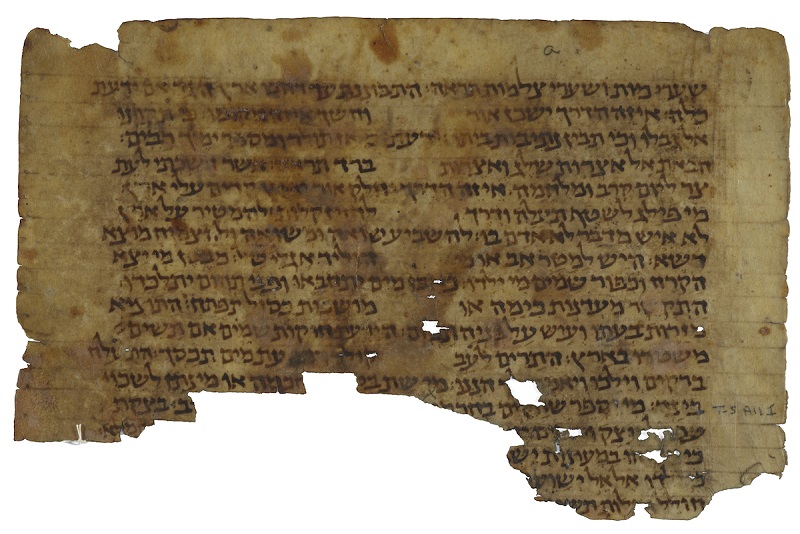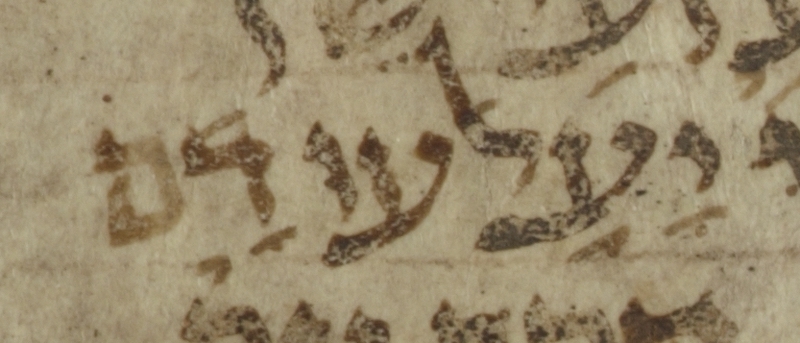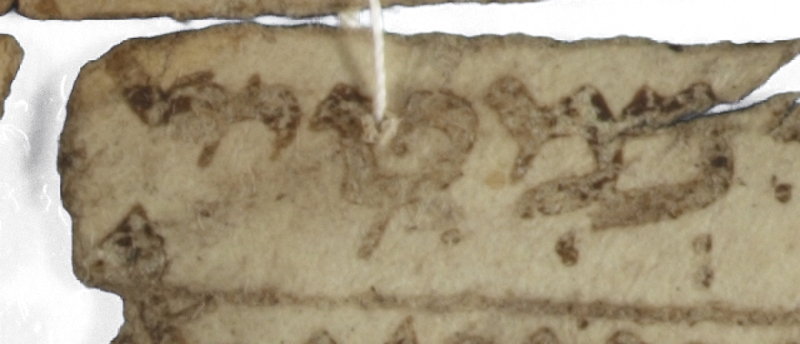Relaxing the Tiberian Standard: T-S A11.1

Standard Tiberian features in Non-Standard Tiberian manuscripts and vice versa, T-S A11.1 P1 B (= f. 1r)
Only during a relatively short period of time was the Hebrew Bible vocalized, i.e., marked with the correct vowel signs, as it was pronounced according to the Standard Tiberian (ST) tradition (Khan 2020a, 85). Thereafter, remnants of manuscripts of the Non-Standard-Tiberian (NST) type, like the Genizah fragment T-S A11.1, indicate a rapid decline in the accuracy of the vocalization and fidelity to the pronunciation of the Standard Tiberian tradition. The reason for this is most likely the removal of the Palestinian Yeshiva from Tiberias to Jerusalem (Khan ibid, 105; Gil, 499–500) and the consequent decline of Masoretic activity in the Galilean centre.
Thus, it is important to distinguish between the vocalisation and the underlying pronunciation in the Tiberian tradition. T-S A11.1 is an intermediary NST manuscript, which shows still an essential knowledge of the ST pronunciation, but that the correct or standardized way of marking it, i.e., the ST vocalization tradition, was lost.
Based on the following two examples, A and B, I will show that there are ST features in NST manuscripts and NST features in ST manuscripts. This will serve as evidence that the ST tradition was slowly lost in the transmission process of the Hebrew Bible.
A: Qamaṣ for Shewa and ḥaṭaf vowels
יָעָלֿעוּ דָֿ֑ם* (T-S A11.1 || L יְעַלְעוּ־דָ֑ם Job 39.30 ‘they (mpl) will suck up’)

Detail from T-S A11.1 P1 F (= fol. 1r)
Shewa at the beginning of the word was, in this case in T-S A11, in accordance with ST rules and still pronounced with the same quality as the vowel under the subsequent guttural letter. The ST grammatical treatise Hidāyat-al-Qāriʾ states that when the four guttural letters א֗ה֗ח֗ע֗ (ʾaleph, he, ḥet, ʿayin) are preceded by a non-guttural letter with a shewa, this shewa is pronounced with the same quality – but a shorter length – as the vowel under the guttural letter itself (Khan 2020b, 138).
In this example, however, two non-standard developments can also be observed:
1. the lengthening of the pronunciation from a reduced vowel, i.e. shewa, to a full vowel, i.e. qamaṣ. This is, according to ST rules, only permissible, if the shewa had been accompanied by a gaʿya (Eldar, 143).
2. the graphical vowel interchange from shewa to qamaṣ, which would not have been permissible even when gaʿya had been marked (Levy, לה).
These two non-standard developments can also be found in Codex Leningradensis B19a (L). L, for instance, changes the originally shewa gaʿya in Ex 29.23 to pataḥ gaʿya. The original vocalization can still be found in the manuscript British Library Or.4445: וַֽחַלַּ֨ת (Leningrad Codex B19a || British Library OR4445 וְֽחַלַּ֨תֿ Ex.29.23 ‘and a cake of’).
B: Shewa for ḥireq
כְמְטִּ֥יל*(T-S A11.1 || L כִּמְטִ֥יל Job 40.18 ‘like bars of’)

Detail from T-S A11.1 P2 F (= fol. 2v)
Shewa is used for ḥireq in the NST manuscript T-S A11.1. This, however, does not show that shewa was pronounced as /i/, but it rather shows the lack of the substitution of the first of two consecutive mobile shewas by ḥireq (Blau, 130f.), a consistent feature in ST manuscripts. Despite the fact that the first shewa did not become ḥireq in T-S A11.1, the second shewa is also silent, as is indicated by the non-standard dagesh in the following letter. We have here, therefore, a shewa in a closed syllable, which is against ST grammatical rules (Levy, יב).
The lack of the substitution of the first of two consecutive mobile shewas by ḥireq, however, can already be found in late ST manuscripts like L (see below examples 1 and 2). Shewa is there twice attested in a closed syllable.1 The only difference between T-S A11.1 and L is that its scribe still adheres to the inherited pronunciation of the subsequent consonant (see example 1), whereas the scribe of T-S A11.1 seems to transmit a later pronunciation and vocalisation tradition. This becomes evident since in the example from T-S A11.1 the letter that follows the originally mobile shewa, receives a non-standard dagesh whereas L (and the Aleppo Codex) marks it with rafe (see example 1). This potentially allows us to date the introduction of this non-standard dagesh in T-S A11.1 to after the period of L and other early and late ST manuscripts (perhaps after the 12th c.), which still show traces of the earlier stage, where pronunciation of the mobile shewa or a full vowel still affects the pronunciation of the following letter (i.e. resulting in rafe):
1) 2בְּשְׂפְֿתֿוֹתֶ֑יךָ (L || Aleppo Codex בְּשִׂפְֿתֿוֹתֶ֑יךָֿ Ps 45:3 ‘into thy lips’)
2) בִֿיְזְרְעֶ֗אל (L || Aleppo Codex בְֿיִזְרְעֶ֗אֿל 2 Kings 9:15 ‘in Jezreel’)
Conclusions
By now it has become evident that the scribes of the NST manuscript T-S A11.1 and others like it3 no longer adhered strictly to the ST tradition. Soley based on example A, it is not clear as to whether they intentionally graphically simplified the vocalisation (full vowels for shewa gaʿya) or whether they also lost this knowledge and vocalised the manuscripts according to their best understanding of how to represent their own pronunciation.4
Based on example B, we can see that the Tiberian pronunciation tradition continued to be developing and that ST was no longer the sole authoritative tradition.
Combining the evidence from examples A and B, we can conclude that it is more likely that the knowledge of the ST vocalisation and pronunciation tradition was slowely lost, and that the NST manuscripts, as well as some sporadic deviations found in later ST manuscripts, indicate this loss.
Footnotes
1 There are more cases in L, where ḥaṭaf vowels occur in closed syllables. I am currently preparing this data for publication.
2 Occurs in L correctly spelled in Ps 59.8.
3 In the near future, the keen reader will be able to find a thorough anylsis of the data in my reworked PhD thesis published by Cambridge University Open Book Publishers.
4 I am currently examining whether the underlying influence of Jewish Palestinian Aramaic (through the Palestinian Reading tradition) could have influenced the vocalisation in NST manuscripts. There is evidence in this manuscript that hints in this direction e.g. ḥireq for seghol: יַעְנִיֽנָּֿהֿ׃ (T-S A11.1 || L יַעֲנֶֽנָּה׃ Job 40.2 'he will answer it (her)'; see also Khan 2020c, 571f.
References
Blau, J. 2010. Phonology and Morphology of Biblical Hebrew. An Introduction (Linguistic Studies in Ancient West Semitic, vol. 2. M. O'Connor et C. L. Miller (eds.)). Eisenbrauns: Winona Lake.
Gil, M. 1992. A History of Palestine 643-1099. Cambridge: Cambridge University Press.
Eldar, I. 1994. The Study of the Art of Correct Reading as Reflected in the Medieval Treatise Hidāyat al-Qāri (Guidance for the Reader) תורת הקריאה במקרא ספר הוריית הקורא ומשנתו הלשונית). The Academy of the Hebrew Language: Jerusalem. [Hebrew].
Khan, G. 2020a. The Tiberian Pronunciation Tradition of Biblical Hebrew, vol. 1. Cambridge, UK: Open Book Publishers.
Khan, G. 2020b. The Tiberian Pronunciation Tradition of Biblical Hebrew, vol. 2. Cambridge, UK: Open Book Publishers.
Khan, G. 2020c. ‘Some Features of the Imperfect Oral Performance of the Tiberian Reading Tradition of Biblical Hebrew in the Middle Ages’. In Studies in Semitic Vocalisation and Reading Traditionsy, edited by Aaron D. Hornkohl and Geoffrey Khan, 549-592. Cambridge, UK: Open Book Publishers.
Levy, K. 1936. Zur masoretischen Grammatik. Texte und Untersuchungen. Kohlhammer: Stuttgart.
Cite this article
Blapp, S. (2021). Relaxing the Tiberian Standard: T-S A11.1. [Genizah Research Unit, Fragment of the Month, December 2021]. https://doi.org/10.17863/CAM.82607
If you enjoyed this Fragment of the Month, you can find others here.
Contact us: genizah@lib.cam.ac.uk The manuscripts in this article are part of the Cairo Genizah Collection in Cambridge University Library. To see more items from this collection visit: https://cudl.lib.cam.ac.uk/
